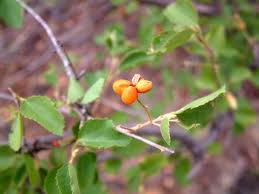| PlantID | 0068 |
| Botanical Name | Grewia tenax |
| Common Name | Phalsa cherry, Gangara |
| Classification | | Kingdom: | Plantae | | Subkingdom: | Tracheobionta | | Division: | Angiospermae | | Class: | Polypetalae | | Subclass: | Magnoliidae | | Order: | Malvales | | Family: | Tiliaceae | | Genus: | Grewia | | Species: | tenax |
|
| Part used | Plant, leaves, twigs, fruits and root. |
| Medicinal Properties | Antitumour, aphrodisiac, free radical scavenging activities and mild antibiotic. |
| Medicinal Use | The plant is widely used for the treatment of various common diseases like upset of stomachs, some skin and intestinal infections, cough, fever, diarrhoea, dysentery, jaundice, rheumatism. Fruits are edible which are nutritionally balanced and rich in iron and calcium and is used for the treatment and prevention of iron deficiency anaemia. A preparation of G. tenax fruit powder mixed with milk is given for the treatment of bone fracture and swelling. Root and fruits: useful in treatment of osteoporosis, tissue and wound healing. Leaves and twigs: are an important component of folk medicine for the treatment of trachoma, tonsillitis, infections and are used as a poultice to treat swelling.
|
| Chemistry | Plant: grewinol, tetratricontane-22-ol-13-one. Seeds: contain 5% of bright-yellow oil containing palmitic acid, stearic acid, oleic acid, linoleic acid and unsaponifiabl32. Drupes: amino acids, mineral elements (K, Ca, Mn, Fe, Cu and Zn), tannin and pectic substances. In preliminary phytochemical studies plant extracts in different solvents were found to contain diterpines, glycosides, fats, alkaloids, glycosides, triterpenoids, sterols flavonoids, saponinsa and tannins. |
| Cultivation | NA |
| Regional Habitat | Commonly found in arid and semi-arid plains upto 1500 m height in sandy, rocky and lateritic soils. The plant is adapted to high temperatures and dry conditions, also has deep roots which stabilize sand dunes. |
| Description | Suberect to erect shrub of up to 3 m in height. Stem: ash-grey bark and young twigs are stellate hairy. Leaves: 3-5-costate, almost glabrous, hairy on both sides, sharply serrate, cuneate at the base, acute to obtuse, rarely emarginate at the apex. Petiole: is 2-14 mm long, hairy and stipules linear-lanceolate, caducous. Flowers: solitary or rarely paired, on solitary, antiphyllous, hairy peduncle, white, rarely yellowish-white, pedicel half as long as peduncle, stellate tomentose. Sepals: linear-oblong. Petals: linear, claw much smaller than limb, with somewhat reniform densely ciliate gland, bilobed at the apex. Stamens: numerous, filaments slightly shorter than style or subequal.Ovary: is 4-lobed, glabrous, rarely stellate hairy; style long, clavate. Drupe: usually 2-4-lobed, lobes are 5-7 mm in diameter, glabrous, rarely with sprinkled stellate hairs, orange yellow with red-dish tinge. Flower and fruits appears commonly during February to August. |
| Image |  |


